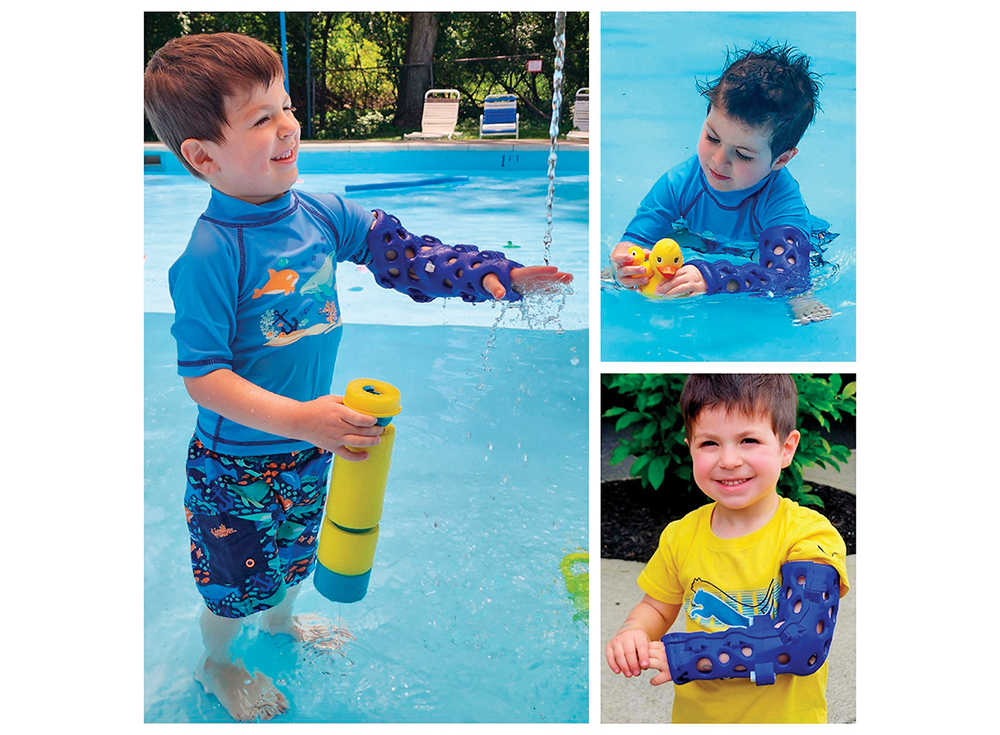
Rising temperatures and fading memories of Shavuot cheesecake herald the beginning of the swimming season. Pools, splash pads and waterfronts can be great places to cool off, but they’ve historically been off-limits for those who’ve had the misfortune of breaking a bone. If you’re stuck in a cast healing a fracture, you can’t swim or shower without a special protective sleeve—and these sleeves are neither cheap nor perfect. They also don’t fit everyone.
Casts have evolved over millennia, from primitive contraptions made of various available natural ingredients (such as tree bark, bamboo, waxes, resins, rawhide and egg-soaked linen) to sand-filled wooden boxes in the 18th century, plaster of paris in the 19th century, and more recently fiberglass shells with underlying padding.
While the exterior shell of a fiberglass cast is water-resistant, the interior padding (typically made from cotton or synthetic material) absorbs water like a sponge. Once wet, whether from a pool, a sudden thunderstorm or bathtime, these casts are nearly impossible to dry. Mold and unpleasant smells soon follow, necessitating another visit to the orthopedist, for a replacement cast. The liners can also be itchy, and both kids and adults have been known to slide dangerous objects like wire hangers inside, seeking some relief.
All of this weighed heavily on my mind when my son was brought to me, crying inconsolably, after a fall. It’s often difficult to tell how serious an injury truly is with a toddler, and as I commonly have to remind people, even orthopedic surgeons don’t have X-ray vision.
He did have a fracture, but baruch Hashem, X-rays showed that it wasn’t displaced—meaning he did not need surgery. However, he did need to be in a cast for a month … from shoulder to hand.
He was initially in a protective splint for the first few days to allow swelling, and during that time, all the typical cast problems I warn my patients about became personal concerns. Bathtime was a struggle, his arm itched, and with the days getting warmer, he kept begging to go to the pool, but plastic cast covers don’t fit well on toddlers.
Thankfully, I knew casts have come a long way since the days of resin and rawhide. There was hope—a plastic waterproof liner material can sometimes be used instead of cotton for certain fractures. It’s better than cotton in some ways, because it’s porous, and can dry off once it gets wet. However, plastic liners aren’t a perfect solution, since they tend to disintegrate over time, kids often pick at and remove them, and they can be really itchy. They also are not an option for every fracture type, as they’re less secure, and some fractures require maximum stability.
While a plastic liner wasn’t a great option for my son, I had recently learned of a futuristic type of cast that might be perfect. An entrepreneur from Colorado had developed a way of fabricating custom 3D printed plastic casts using a scan of a patient’s limb. The casts are stable, protective and completely waterproof.
3D printed casts are made out of the same plastic as Lego, so they’re durable, but are comfortable because of the precise scanning that goes into their creation. They have large perforations that allow air and water to circulate, a design made possible by the additive nature of 3D printing.
In my own practice, I had recommended and used 3D printed casts from a company called ActivArmor for my patients before, but I never realized how much of a difference-maker they really were.
As soon as his swelling allowed, I scanned his arm using their iPhone app. The cast arrived a few days later. I applied it using the included custom fitting kit, putting padding where necessary. The next day, he was splashing in the pool, taking showers without worry, and back to enjoying being a 3-year-old. He seemed to have forgotten entirely that he had a broken arm, and the hardest part of caring for his fracture was slowing him down. The cast was light, roughly the same weight as a fiberglass cast, and he had no problem running around like his usual self.
As an unexpected side benefit, the cast even helped him socially. He made friends everywhere he went. At the pool, in the park, or just out for a stroll, other kids and adults found it fascinating, often remarking that it looked like a superhero arm. Everyone showed interest in learning more about it.
While a 3D printed cast is not the right solution for every patient, it is an option in many cases, and can save patients (and their parents) from the hassles of traditional casting. Classic cast concerns—from infections related to lost pencil erasers, coins and pen caps left behind from a fit of scratching, to the smells generated by a sweaty, four-week old, cotton liner, to the imperfect rubber gaskets in the “waterproof” cast protection sleeves—are all moot with a 3D printed cast.
3D printed casts are only available with a doctor’s prescription, and it is important to remember that they are not always an option—some fractures still need the stability of a handmade touch. However, when they can be used, they are an incredible solution for orthopedic immobilization.
Dr. Joseph A. Rosenbaum is a board-certified orthopedic surgeon with fellowship training in hand and upper extremity surgery. He serves as the clinical director of hand surgery at Holy Name Medical Center. He sees patients in Teaneck, and is proud to offer 3D printed casting as an option when it is appropriate for patients.








